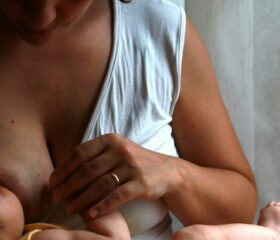Mastitis and Breastfeeding: Symptoms, Treatment, and Prevention
Are you breastfeeding and suffering from a swollen and inflamed breast? If so, you may have mastitis.

Mastitis can be a pain when you’re trying to breastfeed. Luckily, there are ways to deal with it.
Read on to learn about this common breastfeeding challenge, its causes, and what treatments are available so you can manage your symptoms and continue breastfeeding comfortably.
What is mastitis?
Mastitis refers to painful inflammation and swelling of the breast tissue, accompanied by tender areas of redness.
It can happen at any time, but it’s common when you’re breastfeeding (in which case it’s called lactational mastitis or puerperal mastitis). 1 2
About 10% of breastfeeding moms in the US experience lactational mastitis, usually in the first 3 months after childbirth. 3
This condition usually starts out purely inflammatory (meaning your breast is just swollen and tender, but not infected). It may develop into an acute infection if bacteria get involved. This is called bacterial or infectious mastitis, or sometimes just a breast infection. 3 4
What are the signs and symptoms of mastitis?
Mastitis can develop gradually or suddenly, and it normally affects only one breast at a time. You may experience these symptoms: 3 5 6
- Tenderness: The affected breast may feel sore, warm, and painful to the touch.
- Redness: A reddish or pinkish area, often wedge-shaped, may appear on your breast. 7 Note that redness may be harder to see on darker skin tones. 8
- Swelling: Your breast may appear swollen or feel firmer than usual.
- Lump: You may feel a tender lump in the breast tissue. Breasts can normally feel a little lumpy, so pay attention to new or worsening lumps.
- Burning pain: You may feel a burning or painful sensation, especially during breastfeeding.
- Discharge: You may have yellow discharge leaking from your nipple. 9
If you experience these symptoms, they’ll often show up within your first six weeks of breastfeeding. They tend to stick around for 2–5 days, commonly peaking on the second or third day. 6
Symptoms of bacterial mastitis
If you develop bacterial mastitis, you may experience flu-like symptoms, such as: 6 10
- Fever
- Nausea and vomiting
- Chills
- Headache
- Muscle aches
- Fatigue
- Malaise (generally feeling unwell or uncomfortable)
Consult a doctor or lactation consultant if you experience any of these symptoms. Early intervention can help prevent the condition from worsening and ensure appropriate treatment.
What are the causes of mastitis?
Sometimes, your milk ducts can get clogged, resulting in a buildup of milk. This can cause swelling, redness, and stiffness in your breast, also known as engorgement. This happens for a few different reasons: 2 5
- Your breast doesn’t get fully drained: If your breast doesn’t empty enough during feeding, it can lead to blocked milk ducts, milk buildup, and inflammation.
- You have an oversupply of milk (hyperlactation): Producing more milk than your baby needs can cause engorgement and increase the risk of blocked ducts.
- You put too much pressure on your breasts: Tight bras, restrictive clothing, or even the way you carry a bag can compress milk ducts and impede milk flow.
- Your feeding schedule is erratic: Sudden changes in breastfeeding frequency can disrupt milk flow and increase the risk of mastitis. 10 This can happen if your baby missed a feeding or just started sleeping through the night (meaning she’s feeding less frequently). 6 9
- Your baby has a poor latch: When your baby doesn’t latch on properly, it can damage your nipple and potentially make you reluctant to nurse from that breast, which can cause a buildup. 11
What causes bacterial mastitis?
When you breastfeed, bacteria from your skin or your baby’s mouth (e.g., staphylococcus and streptococcus) can enter your milk ducts through their openings or small cracks in your nipple. 1 3
The milk in your breast then becomes a perfect breeding ground for those bacteria, disrupting the balance of the bacteria already inside and leading to an infection.
What are the risk factors for developing mastitis?
You have a higher chance of getting mastitis if you smoke or are in the habit of wearing a tight bra (or anything that puts pressure on the breasts, which may restrict the flow of milk).
You’re also at risk of developing mastitis if you have: 3
- Diabetes or autoimmune diseases
- Breast implants or nipple piercings
- Sore or cracked nipples
- A history of mastitis while breastfeeding in the past
- Improper nursing or latching techniques
- Skin conditions such as eczema
As far as bacterial mastitis goes, you’re more susceptible to a bacterial infection if you have a weakened immune system. The best thing you can do to prevent this is to get lots of sleep, stay hydrated, and maintain a healthy breastfeeding diet. 5
In some cases, a separate infection like thrush (a yeast infection) can also cause inflammation, a blocked milk duct, and mastitis. 3
Mastitis can lead to further complications
If you’re dealing with hyperlactation (too much milk production), you might develop abscesses in your breast. If so, your doctor will need to drain them. You may also develop a milk cyst (galactocele), which is a buildup of milk in one area of your breast. Fortunately, smaller milk cysts sometimes clear up on their own without needing to be drained. 2
How you can treat mastitis at home
The Academy of Breastfeeding Medicine (ABM) recommends focusing on reducing inflammation, managing pain, and preventing infection, while avoiding practices that may exacerbate the condition. 4
In practice, this means that you should wear a well-fitting, supportive bra that doesn’t compress the breasts.
You can also try these breastfeeding techniques:
- Lymphatic drainage: Gently massage the breast towards the lymph nodes in the armpit and above the collarbone to encourage fluid drainage and reduce swelling. Use a light “petting a cat” touch rather than a deep massage.
- Reverse pressure softening (RPS): If your areola is swollen and making it difficult for your baby to latch, RPS can help. Place your fingertips around the base of the nipple and gently press inwards, then draw your fingers back from the nipple.
Other treatment techniques and remedies
If that isn’t enough, you can also try:
- Cold compresses: Apply cold packs to the affected breast for 10–20 minutes at a time after breastfeeding (several times a day) to reduce pain and swelling. 12 13 Be careful if you’re using cabbage cold compresses, as these can contain listeria, which is dangerous to your baby.
- Pain relief: Over-the-counter nonsteroidal anti-inflammatory drugs (NSAIDs) like ibuprofen (Motrin or Advil) or acetaminophen (paracetamol) can help manage pain and reduce fever. 13 Take a dose every 6–8 hours or as often as your doctor thinks is okay.
- Supplements: Ask your doctor about taking 5–10 grams of sunflower or soy lecithin daily by mouth to reduce inflammation and improve milk flow.
If you develop signs of a bacterial infection (e.g., fever, chills, or worsening pain) or your symptoms linger after 24 hours of treatment at home, your doctor may prescribe antibiotics. 1 Make sure you take all your antibiotics, even if you start feeling better.
Can you still breastfeed with mastitis?
Yes—as you may have picked up on by now, not only is breastfeeding still an option if you have mastitis, it’s encouraged to remove milk and prevent further engorgement.
Start each feeding on the unaffected side to encourage let-down, then switch to the affected side. Feed your baby on demand, and pump as needed to relieve milk buildup, but avoid aggressive or long-term over-pumping. 4
Note that you shouldn’t dangle-feed your baby (i.e., putting him on the floor or bed and hovering above him to nurse). This position may help if you have clogged ducts, but it’s considered unsafe. It’s better to recline backwards in a chair with your baby lying on top and massage toward the nipple as your baby feeds. 4
What to avoid when trying to treat mastitis at home
The ABM recommends not doing anything that may aggravate your breast tissue, stimulate an oversupply of milk, or cause further inflammation or trauma to your breasts. Try to avoid: 4
- Using your breast pump for more milk than your baby needs
- Wearing nipple shields
- Wearing tight clothing, underwire bras, or tight straps on a baby carrier 14
- Aggressively massaging your breasts (no deep massages, and don’t use electric toothbrushes or personal massagers on them, even if it feels good)
- Using saline soaks, castor oil, or other topical products
- Cleaning your nipple
You don’t need to go crazy with sterilizing your pump, either. Clean the parts after each use, but cleaning more often won’t help because mastitis isn’t contagious and doesn’t usually result from being unhygienic. 4
Be careful with applying heat to the breast. While some women find it soothing, heat can sometimes worsen symptoms by increasing blood flow.
How can you prevent mastitis to begin with?
Following the treatment steps outlined above can also help prevent mastitis. Here are a few extra pointers:
- Regular feeding: You should breastfeed on demand, and, if possible, keep a regular nursing schedule to prevent engorgement. 2 Avoid long stretches between feedings. 9
- Latch: Ensure your baby is latching correctly to the breast. If you’re having trouble, a lactation consultant can provide guidance on proper latch techniques. 9
- Full drainage: Allow your baby to fully empty one breast before switching to the other. 11
- Gradual weaning: If you’re weaning, do so gradually to allow your body to adjust its milk production.
- Address oversupply: If you have an oversupply of milk, talk to a lactation consultant about strategies to manage it.
Don’t get so focused on your baby that you neglect your own health. Prioritize rest (relax with your feet up), a healthy breastfeeding diet, and your hydration to support your recovery. 13 15 If you live with others, ask for help with chores if needed.
When to see your doctor about your mastitis symptoms
You should consult your doctor if you have any of the following: 3 13 5
- A persistent, high fever over 101.5°F
- Symptoms of mastitis that don’t improve after 24 hours of home treatment
- Recurring episodes of mastitis
- Concerns about your baby’s latch or feeding patterns
- A lump in your breast that spreads or doesn’t go away after treatment
- Dizziness, confusion, racing heartbeat, or fainting
- Pus or blood oozing from your breast
- Red streaks extending from your breast towards your chest or arms
You should also call your doctor if you can’t take any antibiotics they prescribed due to constant nausea and vomiting. 3
If your symptoms don’t improve within 48 hours, your doctor may consider taking a sample of your milk to see exactly what’s going on and may conduct a breast ultrasound to check for an abscess (which, as mentioned, may need to be drained). 1
Final thoughts
Mastitis can be painful and frustrating, but with proper treatment and prevention strategies, you can manage the condition and get some much-needed relief.
Seek professional guidance from your doctor or a lactation consultant if you need, especially if you notice any concerning symptoms.
Article Sources
- StatPearls. "Acute Mastitis" Retrieved September 15, 2025.
- Von Voigtlander Women's Hospital. "Mastitis: Inflammation of the Breast" Retrieved September 15, 2025.
- UCHealth. "Mastitis" Retrieved September 15, 2025.
- Academy of Breastfeeding Medicine. "Academy of Breastfeeding Medicine Clinical Protocol #36: The Mastitis Spectrum, Revised 2022" Retrieved September 15, 2025.
- Office on Women’s Health. "Your Guide to Breastfeeding" Retrieved September 15, 2025.
- Children's Hospital of Philadelphia. "What is breast mastitis?" Retrieved September 15, 2025.
- Johns Hopkins Medicine. "Mastitis" Retrieved September 15, 2025.
- La Leche League International. "Mastitis and Sore Breasts" Retrieved September 15, 2025.
- Harvard Health Publishing. "Mastitis: What to do when your breasts are painfully inflamed" Retrieved September 15, 2025.
- Colorado WIC Program. "Nutrition Risk Manual" Retrieved September 15, 2025.
- Vital Record. "Breastfeeding: Blocked milk ducts, mastitis and more" Retrieved September 15, 2025.
- UCSF Health. "Postpartum: Now that You’ve Given Birth" Retrieved September 15, 2025.
- UCSF Health. "Breast inflammation: Plugged Ducts and Early Mastitis" Retrieved September 15, 2025.
- Children's Hospital of Philadelphia. "Plugged Milk Ducts" Retrieved September 15, 2025.
- Office on Women’s Health. "Your Guide to Breastfeeding" Retrieved September 15, 2025.







